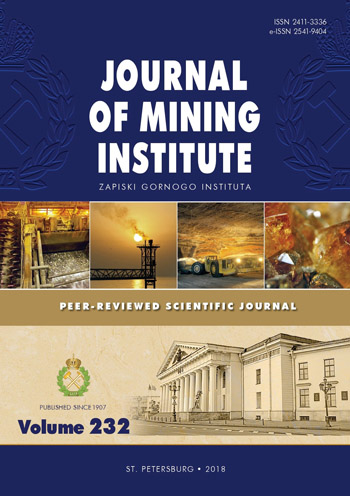Problems of interaction with stakeholders during implementation of long-term mining projects
- 1 — Silesian University of Technology
- 2 — Saint-Petersburg Mining University
- 3 — Saint-Petersburg Mining University
Abstract
Since mining projects have a long-term character, the activity of mining companies is closely linked with the development of regions of their presence. The main external stakeholders in long-term mining projects are the local population, public authorities of various levels and local governments. In Russia, mining projects are being implemented both in the industrialized territories and in the new mining regions, therefore the interests and the degree of influence of the stakeholders are different. In European countries, acting mining companies operate in areas with a high level of urbanization, having a significant impact on the quality of life of the population and the development of regions. In addition, one of the key industry stakeholders in the implementation of mining projects is the European Union. The article describes the characteristic features and conditions for interaction between the initiators of long-term mining projects with different categories of stakeholders. The models of identification, classification and management of stakeholders have been analyzed, approaches to the analysis of the nature of stakeholder interaction in the implementation of projects in the mineral sector have been substantiated. To determine the degree of influence, interest of the authorities and identification of definitive groups of stakeholders in long-term mining projects, matrices for classification of stakeholders in the construction projects of «Elegestsky GOK» and «Tominsky GOK» have been created. It is proved that effective interaction with stakeholders determines the opportunities for timely implementation of mining projects and increase of the company value.
References
- Abrosimova A.B., Sedel'nikova I.M. System analysis of stakeholders. Vestnik Inzhekon. Seriya «Ekonomika». 2011. N 3, p. 222-230 (in Russian).
- Blagov Yu.E. Corporate social responsibility: the evolution of the concept. St. Petersburg: Izd-vo «Vysshaya shkola menedzhmenta», 2010, p. 272 (in Russian).
- Petrov M.A. Stakeholder Theory: Ways of Practical Application. Vestnik SPbGU. Ser. 8. 2004. Iss. 2 (N 16), p. 51-68 (in Russian).
- Ponomarenko T.V., Vol'nik R., Marinina O.A. Corporate social responsibility of the coal industry (practice of Russian and European companies). Zapiski Gornogo instituta. 2016. Vol. 222, p. 882-891. DOI: 10.18454/PMI.2016.6.882 (in Russian).
- Resource model of economic modernization: opportunities and limitations. Ed. by. V.B.Kondrat'ev. Moscow: IMEMO RAN, 2016, p. 326 (in Russian).
- Ryabova L.A., Didyk V.V. Social license for the activities of resource companies as a new tool for social development. Voprosy gosudarstvennogo i munitsipal'nogo upravleniya. 2015. N 3, p. 61-82 (in Russian).
- Tambovtsev V.L. The stakeholder theory of the firm in the light of the concept of ownership regimes. Rossiiskii zhurnal menedzhmenta. 2008. Vol. 6. N 3, p. 3-26 (in Russian).
- Tret'yak O.A. Corporate social responsibility of Russian companies. Rossiiskii zhurnal menedzhmenta. 2015. N 2. URL: http://www.marketing.spb.ru/mr/business/Corporate_Governance.htm (date of access 27.09.2016) (in Russian).
- Bijańska J., Wodarski K. Defining a strategy of coal enterprises in crisis situation. 4th BE-ci. International Conference on Business & Economics, 05-07 June, 2017, Brno, Czech Republic. Ed. by: Zafer Bekirogullari, Melis Y. Minas & Roslind X. Thambusamy. Brno: Future Academy. 2017, p.91-105.
- Bluszcz A. European economies in terms of energy dependence. Quality and Quantity. 2017. Vol. 51. N 4, p. 1531-1548.
- Cameron B.G., Seher T., Crawley E.F. Goals for space exploration based on stakeholder network value considerations. Acta Astronautica. 2010. N 68 (11-12), p.2088-2097. DOI: 10.1016/j.actaastro.2010.11.003
- Freeman R.E. Stakeholder Management: A Stakeholder Approach. Marshfield, MA: Pitman Publishing, 1984, p.275
- Kang K.H., Lee S., Huh C. Impacts of positive and negative corporate social responsibility activities on company performance in the hospitality industry. International Journal of Hospitality Management. 2010. N 29 (1), p. 72-82.
- Fletcher A., Guthrie J., Steane P., Pike S. Mapping stakeholder perceptions for a third sector organization. Journal of Intellectual Capital. 2003. N 4(4), p. 505-527. URL: http://ir.knust.edu.gh/bitstream/123456789/4261/1/ATIIBO%20KENNEDY%20AYATAH.pdf (date of access 7.12.2017).
- Mendelow A. Stakeholder Mapping // Proceedings of the 2nd International Conference on Information Systems. Cambridge: MA, 1991. URL: http://www.termpaperwarehouse.com/essay-on/Stakeholder-Mapping/140410 (date of access 7.12.2017).
- Michalak A., Nawrocki T. Comparative analysis of the cost of equity of hard coal mining enterprises – an international perspective. Gospodarka Surowcami Mineralnymi. 2015. Vol.31. Z. 2. P. 49-72.
- Mitchell R.K., Agle B.R. & Wood D.J. Toward a Theory of Stakeholder Identification and Salience: Defining the Principle of Who and What really Counts. Academy of Management Review. (Oct., 1997). Vol. 22. N 4, p. 853-888.
- Nevskaya M.A., Marinina O.A. Regulatory Aspects of Mining Waste Management in the Russian Federation. Biosci., Biotech. Res. Asia. December 2015. Vol. 12(3), p. 2619-2628. URL: http://www.biotech-asia.org/vol12no3/regulatory-aspects-ofmining-waste-management-in-the-russianfederation/ (date of access 5.02.2018).
- Ponomarenko T.V., Marinina O.A. Corporate responsibility of mining companies: Mechanisms of interaction with stakeholders in projects implementation. Journal of Applied Economic Sciences. 2017. Vol. 12(6), p.1826-1838.
- Raza A., Ilyas M.I., Rauf R., & Qamar R. Relationship between Corporate Social Responsibility (CSR) and Corporate Financial Performance (CFP): literature review approach. Elixir Financ. Manag. 2014. 46, p. 8404-8409.
- Savage G.T., Nix T.W. Whitehead and Blair. Strategies for assessing and managing organizational stakeholders. Academy of Management Executive. 1991. N 5(2), p. 61-75.
- Sienkiewicz-Małyjurek K. Impact of climate changes on the European industry. Metalurgija. 2014. Vol. 53. Iss. 2, p. 254-256.
- Turek M. Techniczno-organizacyjne aspekty zgazowywania węgla w podziemiach czynnej kopalni, na przykładzie eksperymentu przeprowadzonego w kopalni Wieczorek. Przemysł Chemiczny. 2015. Vol. 94. N 6, p. 1012-1017.
- Turner J.R., Kristoffer V. & Thurloway L. The project manager as change agent. London: McGraw-Hill Pablishing Co, 2002, p. 264.
